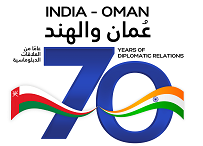Menu
Bilateral
Trade & Commerce
Labour & Community Welfare
Consular
Education
Culture & Tourism
Media Center
What's New
Press release
Back | PrintFollowing the grand Opening Ceremony of the Festival of India with performance of the Hritaal Dance Troupe in Muscat, Sur, Salalah and Sohar, the Embassy of India, Muscat, is pleased to present, as part of the Festival of India in Oman 2016, a real treat for calligraphy enthusiasts, art lovers and historians alike: A unique Exhibition of Islamic Calligraphy from the collections of Rampur Raza Library, India. His Excellency Hassan bin Mohammed al Lawati, Adviser to the Minister of Heritage and Culture for Heritage of Oman will be inaugurating the Exhibition on 21st November 2016.
The Exhibition will be on display from 21st November to 3rd December 2016 at Promenade Garden (level2) Oman Avenues Mall and can be viewed anytime during the opening hours of the Mall, is free and open to all.
Over 40 pieces of calligraphic artwork artistically inscribed with selected verses from the Holy Quran have been showcased at the exhibition. The Holy Quran has played a great role in the development and evolution of Arabic, and by extension, Arabic calligraphy.
Among the rare calligraphic manuscripts exhibited are:
• Folio from 7th century Quran in Kufic script attributed to Hazrat Ali (R.A.)
• Folio from 8th century Quran in Kufic script attributed to Imam JafarSadiq
• 16th century Quran decorated with gold on the orders of Mughal Emperor Akbar
• 12th-18th century manuscript folio written within gold floral jidwal
• A folio from 9th century Quran in Kufic script attributed to Imam Raza
• Name of Nawab Kalb-i-Ali Khan written in the shape of a flower pot in 18th century
• Persian verses & text written in Arabic Language in 1887. A.D
• Quranic verses written in beautiful style of calligraphy in 1888 A.D
• Persian couplet written in a beautiful style of calligraphy in 1878 A.D. by Ghulam Rasool
• 18th century calligraphy by Muhammad Hasan
• A verse from Quran about the direction of "Darood-e-Pak" by Dullah Khan KhushraqamRampuri in 1936 AD.
• A beautiful calligraphy of "AyatuIKursi" of 18th century
• Persian rubai relating to the importance of calligraphy by Ilahi Bakhsh of 18th century
• A verse from Quran and "Kalma-i- Tauheed" by Dullah Khan KhushraqamRampuri in 1936 A.D.
• Bismillah-al-rehman-nir-raheem" & "Darood-e-Pak" by Muhammad Hasan in 1869 A.D.
• Saying of Hazrat Ali (R.A.) relating to importance of calligraphy & writing by Aaqa Ali Qari in 18th century
• Five Ahadis & few Quranic verses in praise of Prophet Muhammad & Hazrat Ali (R.A.) by Syed Abdul Abbas Naqvi al Bukhari, etc.
The Rampur Raza Library is a treasure house of Indo Islamic learning and arts which was setup by the erstwhile Rampur State which was founded by Nawab Faizullah Khan in 1774, who ruled the State up to 1794 and formed the nucleus of the library through his inherited collection of valuable manuscripts, historical documents, Mughal miniature paintings, books and other works of art kept in the Nawabs Toshakhana. He also substantially added to the collection by his acquisition. Nawab Muhammad Yusuf Ali Khan Nazim was a literary person and a famous poet of Urdu and a disciple of celebrated poet Mirza Ghalib. He created a separate department of the library and shifted the collection to the newly constructed rooms of Kothi Genralie. The Nawab also invited well known calligraphers, illuminators and binders from Kashmir and other parts of India. The later Nawabs continued to enrich the collection.
Nawab Kalbe Ali Khan (1865-87) was a distinguished scholar and very much interested in collection of rare manuscripts, paintings, and commissioned connoisseur scholars to obtain rare manuscripts, paintings and other art objects and thus enormously enriched the library collection.
Muscat, 21 November 2016













